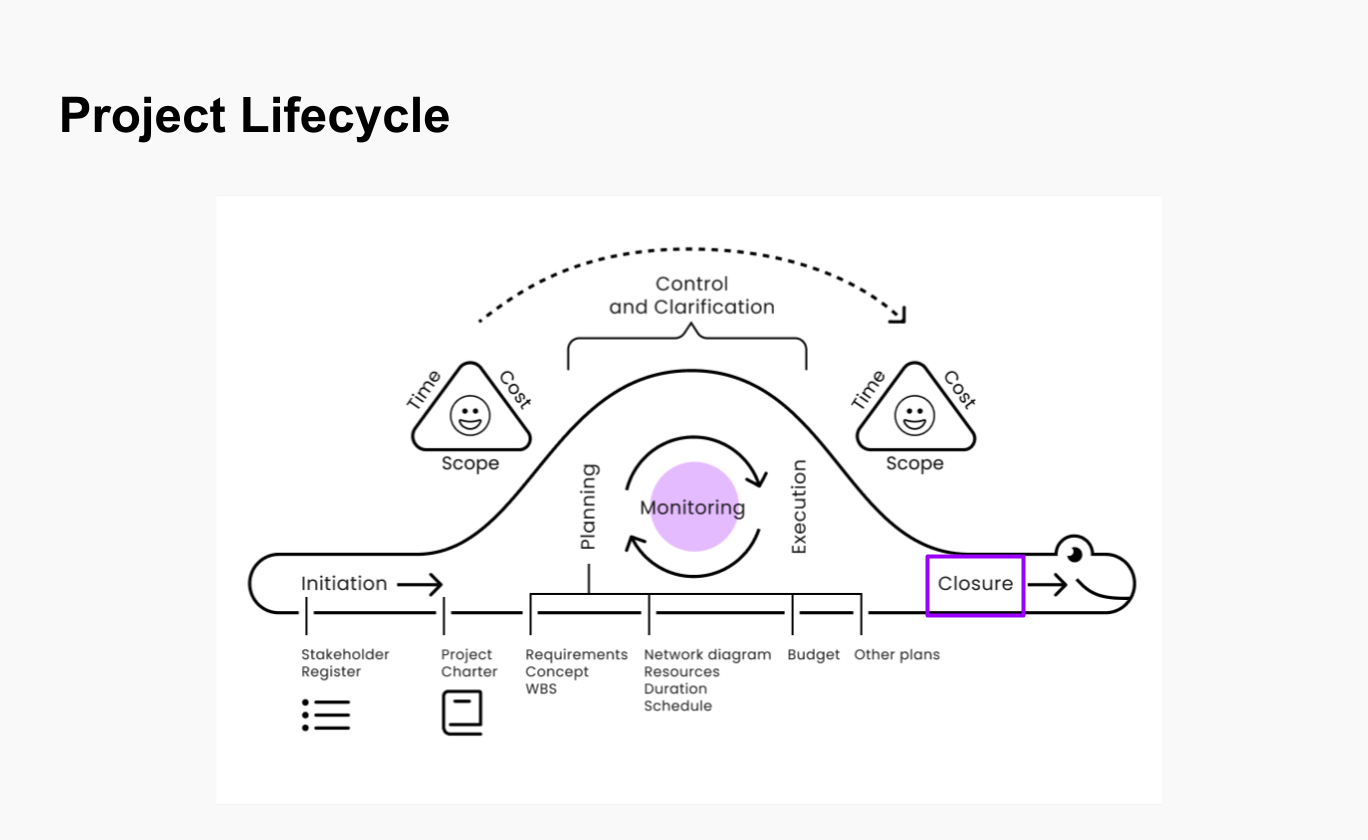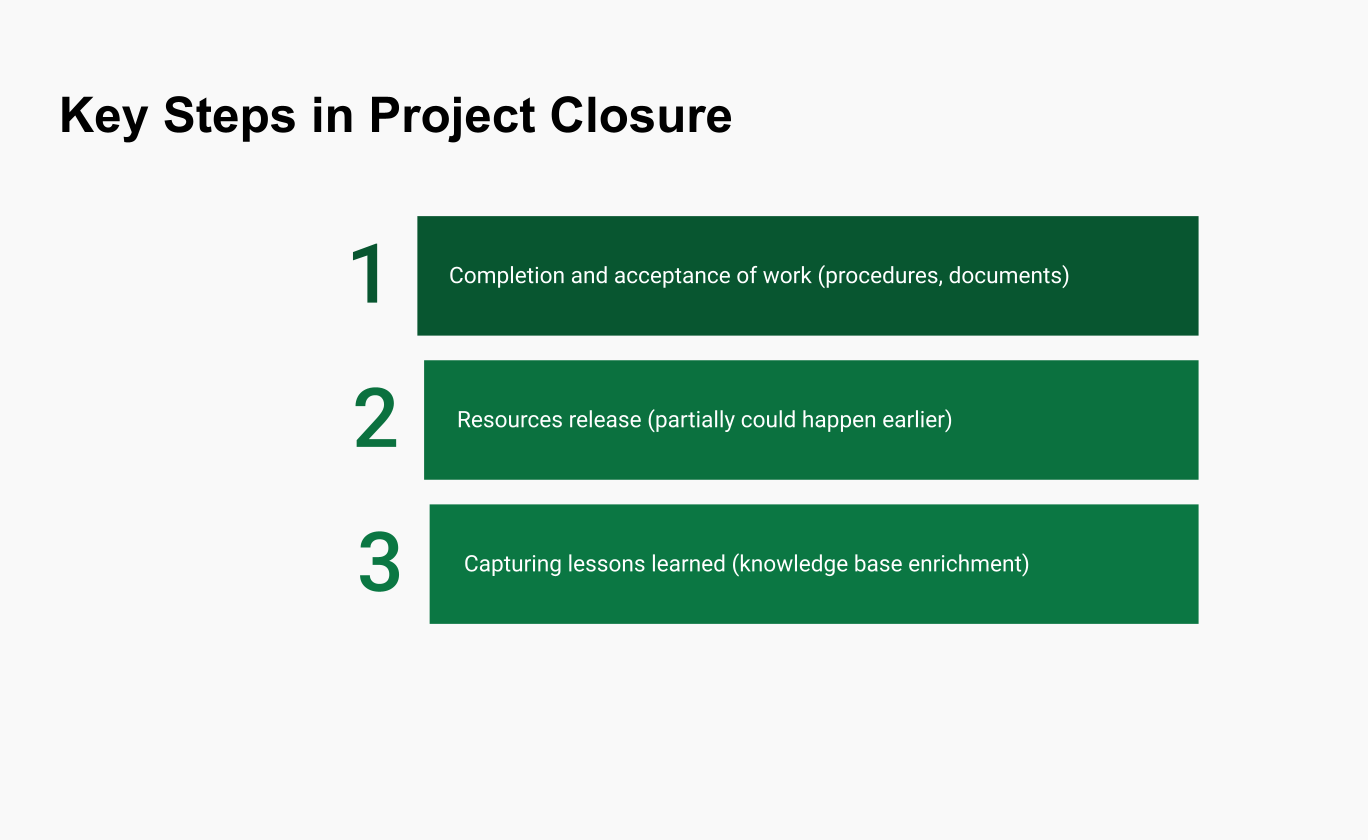Project Closure: A Guide to Wrapping Up Successfully
October 20, 2024 · 7 min read
Every project, whether it's successful or not, must come to a close. Just like the beginning of a project, its closure mirrors that process with the same level of care and attention.
What is Project Closing?
Project closing is the final phase of the project management lifecycle, where all project activities are officially completed. It’s like the closing ceremony of a big event: everything gets wrapped up, loose ends are tied, and the results are handed over. You’re not just saying, “We’re done!” but ensuring that the project has met all its objectives, and the client or stakeholders are satisfied.

How to Close a Project: 7 Steps to Close a Project
What are some of the major activities of project closure? Here’s a simple guide:
- Complete Deliverables. Ensure all project outputs are finalized and meet the required standards. This is where we formally mark the end of project activities and ensure that all deliverables have been completed as agreed upon. The goal here is to prevent scope creep (when uncontrolled changes or continuous growth of scope happen).
- Get Stakeholder Approval. Present the final deliverables to stakeholders and get their formal approval. Whether or not documents are required depends on the nature of your company and industry, but it’s crucial to get written confirmation from the customer or users that the project meets their expectations.
- Release Resources. Inform team members and resources that their work is officially complete. From this point forward, no one is expected to work on the project. If any new tasks related to the project arise, they should be directed to the project manager, not the project team. It's essential that everyone understands this shift to avoid confusion later.
- Close Contracts. Finalize any third-party contracts, pay any pending invoices, and confirm everything is wrapped up.
- Have a Project Closure Meeting. Gather your colleagues for one final meeting (this could be in person or virtual) to officially declare that the project has concluded—whether it was successful or not. Just like the kickoff introduced the team to the project, project closure marks the formal end of their involvement. Discuss what worked, what didn’t, and how to improve for future projects.
- Capture Lessons Learned. This is one of the most valuable steps of the project closure process. You should document everything that went well, as well as what could be improved in the future. This might include insights on the project charter, risk registry, work breakdown structure (WBS), or observations about team performance and client feedback. It helps future projects avoid pitfalls and replicate successes.
- Celebrate Success. Don’t forget to celebrate with your team! Closing a project is a big deal.
Project Closure Checklist
- All deliverables are completed and approved.
- Stakeholders have signed off on the project.
- All contracts are closed, and payments are made.
- The project budget is reconciled.
- A lessons learned meeting has been conducted.
- All project documentation is archived.
- Team members and resources are released or reassigned.
- A closure celebration has taken place!
Project Closure Report
A project closure report is a vital document that signals the official end of a project. It provides a comprehensive summary of the project's performance and ensures all loose ends are tied up. Here's how to make one:
- Overview and Objectives. Start by outlining the project's initial objectives and scope, highlighting what the project set out to achieve.
- Performance Summary. Evaluate the project’s performance, comparing actual results with initial goals. Include metrics on budget, timeline, and deliverables.
- Key Deliverables. Document the final outcomes and deliverables that were handed over to the client or stakeholders.
- Challenges and Resolutions. Identify the challenges encountered during the project and how they were addressed.
- Lessons Learned. Share insights gained from the project, focusing on what worked well and areas for improvement.
- Stakeholder Feedback. Gather and incorporate feedback from key stakeholders on the project’s success and areas for future improvement.
- Handover and Transition. If ongoing maintenance or support is required, detail the handover process and responsible teams. Finalize the report by obtaining sign-offs from key stakeholders, ensuring the project is officially closed.
Which Step Is Most Important for a Project to Close?
The most critical step is getting stakeholder approval. Without that, the project isn’t technically closed. It’s like having a gift but forgetting to wrap it up—it’s not complete until it’s properly handed over.
What Can Be the Chief Challenge in Closing Out a Project?
One of the biggest challenges can be stakeholder disagreements or delays in approvals. Sometimes, stakeholders can change their minds about deliverables or want additional work, which can drag out the closure process. Clear communication and setting expectations early can help prevent this.
Why Is Project Closing Important?
Imagine baking a cake and forgetting to take it out of the oven—disaster, right? The same goes for projects. Without a proper closure, you might miss out on crucial tasks like reviewing what went well, what didn’t, and formally handing off the final product. Project closing helps ensure no resources are wasted, lessons are learned, and everyone involved knows the project is complete.
Conclusion
In conclusion, project closure is an essential, yet often overlooked, phase of the project management. It ensures that all deliverables are completed, stakeholder expectations are met, and resources are released. By following a structured closure process—finalizing contracts, holding closure meetings, and capturing lessons learned—you can wrap up projects efficiently and set the stage for future success. Proper project closure not only solidifies the achievements but also prevents unresolved issues from resurfacing, allowing teams to move forward with clarity and confidence. Ultimately, it’s the key to ensuring that every project ends on a high note.
About the Author
Violetta Chernobuk is a skilled content strategist and writer at Planyway, specializing in crafting insightful and engaging articles on productivity and project management. With her keen eye for detail and a deep understanding of user needs, Violetta ensures that every piece of content is both informative and inspiring, helping readers optimize their workflows and stay ahead in their projects.



